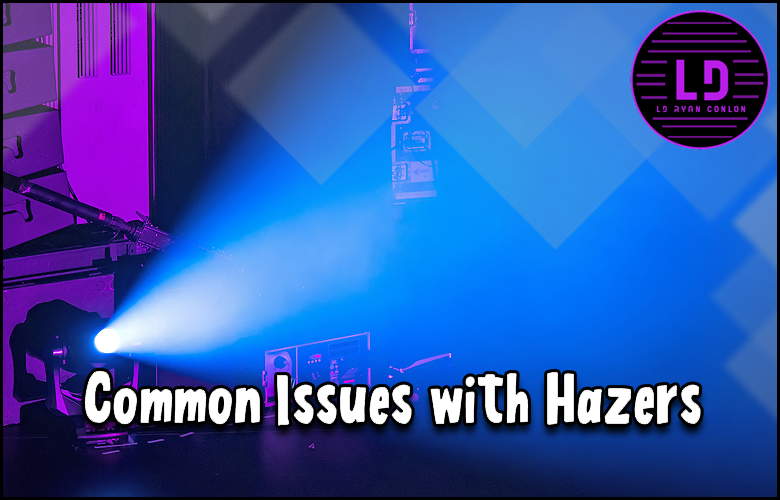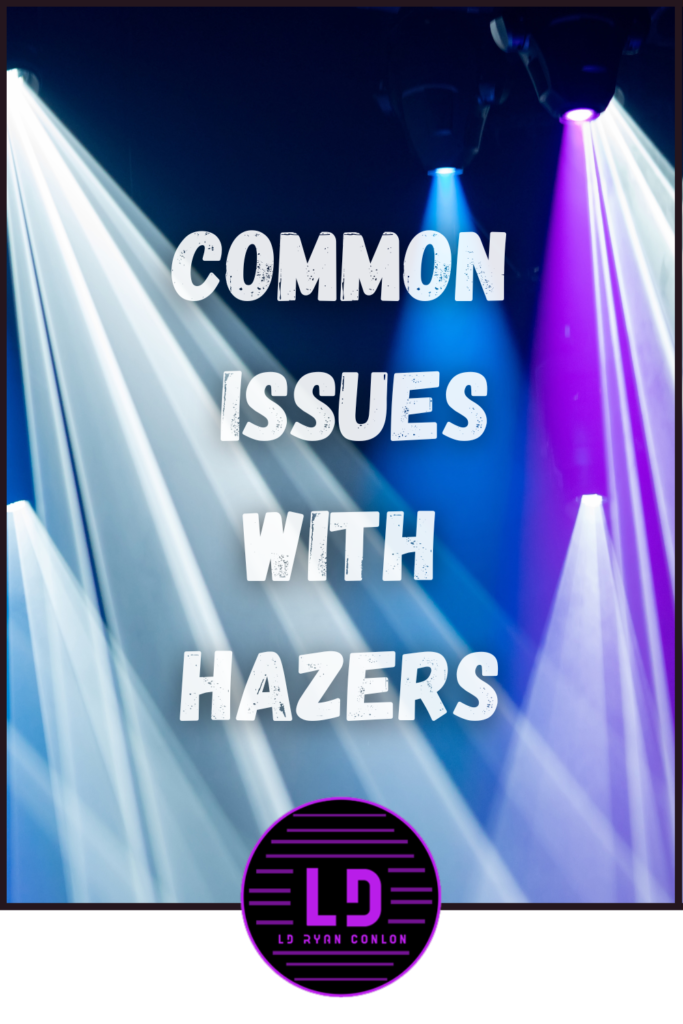
Last Updated on December 13, 2023 by LD Ryan Conlon | 🕒 7 min Read Time
As the footlights come up and the curtain parts, a moody wash of grey mist unfurls, enveloping the stage in an ethereal glow.
This captivating haze is as essential to the production as the sets and lighting, setting mood, building suspense, and ultimately drawing audiences deeper into the world of theatrical magic.
But what happens when this vital component rewrites the script with sudden malfunctions or inconsistent output?
Your once evocative foggy labyrinth can quickly turn into a disorienting pea-soup melee.
In the chaotic world backstage of any theater production, there’s an unsung hero, wrangling not with lines or light cues but with these mysterious machines: The Hazer Technician.
To them, troubleshooting hazer issues isn’t just about preserving atmosphere – it’s akin to battling a smoke-breathing dragon smack in the middle of Act 2.
Whether you’re a seasoned tech or new to the theater world, encountering issues with your stage hazers can feel like defusing a ticking bomb under pressure.
But fear not! We’ve gathered comprehensive tips and tricks to help you troubleshoot common problems with stage hazers effectively and efficiently.
After all, tuning up your hazer should never be as dramatic as what’s going on onstage!
Common issues with stage hazers may include clogged nozzles, inconsistent output, or failure to produce haze. To troubleshoot these issues, ensure the nozzle is clean and clear of any debris, check the fluid level and quality, verify proper power supply, and adjust settings such as fan speed and output level. If problems persist, consult the manufacturer’s manual or contact their customer support for further assistance.
Understanding Hazers and their Common Issues
Stage hazers are a crucial component of any theatrical production or live event.
They create a captivating atmosphere by dispersing a fine mist of haze, enhancing lighting effects, and adding depth to the performance.
However, like any piece of equipment, stage hazers can encounter issues that may disrupt the flow of a show if not addressed promptly.
In this section, we will delve into some common problems that arise with stage hazers and explore ways to troubleshoot them effectively.
One common issue that often plagues stage hazers is clogging.
Over time, residue from the haze fluid can accumulate in the machine’s delivery system, causing blockages and preventing the proper dispersion of haze.
This leads to erratic output or even complete failure. When faced with this problem, it is important to regularly clean and maintain your stage hazer.
Follow the manufacturer’s instructions for cleaning and use recommended cleaning solutions to ensure optimal performance.
A helpful analogy to understand clogging in stage hazers is that of a faucet in a kitchen sink with hard water.
If the faucet is not cleaned regularly, mineral deposits build up, causing reduced water flow or even blockages.
Similarly, haze machines may experience reduced output or clogged delivery systems due to the buildup of residue from haze fluid.
Cleaning your haze machine regularly can prevent clogging issues and keep your performances running smoothly.
Another issue that might arise when using stage hazers is inconsistent output or low haze density.
This can greatly affect the overall ambiance and desired visual effects of a show.
Several factors can contribute to this problem, including improper calibration of the machine, poor maintenance, or using subpar haze fluid.
To troubleshoot this issue, start by checking if the machine is calibrated correctly according to the manufacturer’s instructions.
Ensure that there are no obstructions hindering the flow of air through the machine.
Additionally, make sure you are using high-quality haze fluid that is compatible with your specific stage hazer.
For instance, I recall a production where the stage haze was consistently thin and lacked the desired density.
After thorough investigation, it was discovered that the haze fluid being used was a low-quality brand that did not produce the desired effect.
Switching to a higher quality fluid immediately improved the output and created the desired atmosphere for the performance.
Moreover, overheating is another common issue that can occur with stage hazers, especially if they are being used for extended periods or in high-intensity performances.
Overheating can lead to reduced lifespan and performance of the machine or even cause it to shut down unexpectedly.
To prevent overheating, it is important to monitor the operating temperature of your hazer during use.
Ensure that there is proper ventilation around the machine and that it is not placed near heat sources or enclosed spaces.
Additionally, some stage hazers come equipped with built-in temperature sensors and automatic shutdown mechanisms to protect against overheating.
These features help mitigate the risk of damage to both the hazer and its surroundings.
By regularly checking and maintaining optimal operating temperatures, you can ensure uninterrupted performances and extend the lifespan of your stage hazer.
While these are just a few examples of common issues encountered with stage hazers, it is essential to understand that not all systems are created equal.
Different manufacturers offer various models with unique specifications and potential problems.
In the following section, we will explore how two prominent manufacturers, Antari Lighting and Effects, and MDG Atmosphere, have different systems that present their own set of issues.
Unique, Antari and MDG Atmosphere: Different Systems, Different Issues
Antari Lighting and Effects and MDG Atmosphere are renowned manufacturers in the field of haze machines.
Each company offers distinct systems with their own advantages and possible drawbacks. Understanding these differences is crucial when troubleshooting issues specific to their products.
Antari Lighting and Effects prides itself on providing a wide range of haze machines suited for various applications.
From foggers and jet hazers to battery-powered options, they offer versatility in their product lineup.
One common issue reported with some Antari haze machines is the formation of residues on optical surfaces over time.
This can negatively impact the quality of the haze effect being produced, resulting in a hazy, cloudy appearance rather than a clear, atmospheric mist.
To address this issue, regular maintenance and cleaning are paramount.
Antari offers accessories such as control modules, remote controls, and liquid supply options for their haze machines, which greatly aid in maintaining optimal performance.
It is recommended to follow the manufacturer’s instructions and use appropriate cleaning solutions to prevent residue buildup on optical surfaces.
On the other hand, MDG Atmosphere specializes in high-end professional haze generators.
Their systems are known for delivering exceptional quality and reliability in demanding environments.
However, due to the complexity and sophistication of their systems, one potential issue that may arise is the need for specialized maintenance and calibration procedures.
I once encountered a situation where an MDG Atmosphere haze generator was producing inconsistent output despite proper calibration according to the user manual.
After contacting technical support, it was revealed that recalibration should be performed by qualified technicians every few months to ensure accurate performance.
This highlights the importance of understanding unique requirements and following recommended maintenance practices specific to each manufacturer’s system.
In addition to manufacturer-specific issues, external factors such as environmental conditions can play a significant role in the performance of hazers from any brand.
Humidity levels, temperature variations, and air quality can all influence how effectively haze disperses throughout a venue.
Consider a wind turbine generating electricity. Its efficiency is affected by various external factors such as wind speed, temperature, and air density.
Similarly, hazers can be affected by the environment in which they are operated.
High humidity levels can cause haze particles to clump together, reducing their dispersal and creating inconsistent effects.
Extreme temperatures can also impact the functioning of the haze machine, leading to overheating or decreased output.
Now that we have explored some common issues associated with stage hazers and understood how different manufacturers may present unique challenges, it is time to delve into effective troubleshooting processes.
By recognizing these problems and their potential causes, we can develop strategies to address them and ensure seamless performances.
In the next section, we will discuss the steps involved in nailing the troubleshooting process for stage hazers.
Nailing the Troubleshooting Process
When it comes to operating stage hazers, it’s important to be prepared for any issues that may arise.
No matter how well-maintained your haze system is, there can still be occasional glitches or malfunctions.
That’s where troubleshooting comes into play – the process of identifying and resolving problems to ensure a smooth and successful performance.
In this section, we will discuss some common issues you might encounter with stage hazers and provide tips and tricks to help you nail the troubleshooting process.
Let me share an anecdote from my experience as a lighting technician at a music festival.
One evening, just moments before the main act was about to take the stage, the haze from our hazer suddenly stopped flowing.
Panic ensued backstage as we desperately tried to figure out what went wrong.
After a few minutes of troubleshooting, we discovered that there was a loose connection in the DMX cable between the lighting console and the hazer.
Once we fixed the connection, the haze started flowing again, saving us from a potential disaster.
One of the most important aspects of successful troubleshooting is careful observation and analysis.
When an issue occurs, take a moment to assess the situation. Is there no haze at all? Is the haze output weaker than usual?
Are there any error messages on the hazer control panel?
By gathering as much information as possible, you can narrow down the potential causes and focus your efforts on finding a solution.
Consider another scenario where you notice that your hazer is producing an excessive amount of haze or creating dense clouds instead of a subtle atmosphere.
This could be due to factors such as incorrect fluid settings, blockages in the nozzle or tubing, or even a malfunctioning fan inside the hazer unit.
By meticulously examining these components and making necessary adjustments or repairs, you can restore your hazer to its optimal performance.
It’s also worth mentioning the importance of having a backup plan in case troubleshooting doesn’t immediately solve the issue.
Sometimes, technical problems can be more complex than they appear on the surface.
In such cases, it might be necessary to consult with an expert or contact the manufacturer for further guidance.
While it’s always ideal to resolve issues on your own, don’t hesitate to seek professional help if needed.
I recall a situation where we encountered persistent haze output problems despite our best efforts to troubleshoot.
In this particular case, we reached out to the hazer manufacturer’s customer support team and they were able to provide us with step-by-step instructions to diagnose and rectify the issue.
Their expertise and guidance proved invaluable in getting our hazer back up and running smoothly.
Think of your hazer as a delicate instrument, much like a musical instrument.
Just as a musician must tune their instrument regularly to ensure it produces its best sound, you too must tune and troubleshoot your hazer to maintain its optimal performance.
The more familiar you become with your hazer’s quirks and how to address any potential issues, the smoother your performances will be.
Recognizing and Remedying Overheating Hazers
The issue of overheating is something that many stage hazer operators have had to contend with at some point.
When a haze machine gets too hot, it can result in decreased performance, unwanted shut-offs, or even damage to the internal components.
In this section, we will explore the signs of an overheating hazer, discuss potential causes, and provide effective solutions to remedy this common problem.
Picture this: You’re in the middle of an important theater production, and suddenly you notice that your hazer has stopped producing haze altogether.
Upon closer inspection, you feel an intense heat emanating from the unit.
This is a clear indication that your hazer has overheated and needs immediate attention.
There are several factors that can contribute to a hazer overheating.
One of the most common causes is prolonged use without adequate cool-down periods.
Haze machines generate heat through their internal mechanisms, and without proper cooling, this heat can build up and affect the performance of the machine.
Additionally, operating a hazer in an environment with high ambient temperatures or poor ventilation can exacerbate the issue.
Let’s say you’re using a water-based hazer during a particularly hot summer outdoor concert.
The combination of the ambient temperature and the heat generated by the hazer itself can lead to excessive heat accumulation inside the unit.
If not addressed promptly, this can result in diminished haze output or even cause the hazer to shut down completely.
On the other hand, some may argue that overheating is inevitable for certain types of hazers, especially oil-based models known for their long-lasting and powerful haze output.
While it’s true that these hazers tend to generate more heat compared to their water-based counterparts, it doesn’t mean that overheating should be accepted as normal.
It’s still important to monitor the temperature and take preventive measures to avoid any adverse effects on your performance.
Recently, during a theater production where we were using an oil-based hazer with extraordinary haze coverage, we noticed that the hazer started emitting an unpleasant smell and automatically shut down after running continuously for an extended period.
We quickly realized that the unit had become too hot due to insufficient cooling during its operation.
By implementing a more diligent cool-down routine between scenes and making sure the unit had proper airflow, we were able to prevent further overheating incidents.
Think of an overheating stage hazer like an athlete who pushes themselves beyond their limits without allowing their body to recover.
Just as athletes require proper rest and care to avoid overheating or burnout, hazers also need the right conditions and attention to ensure they perform optimally.
By recognizing the signs of overheating and taking proactive steps to mitigate it, you can safeguard your hazer’s longevity and reliability.
Guarding Your System: The Maintenance Way
Maintaining a stage hazer system is essential to ensure its optimal performance and longevity.
Just like any other piece of equipment, hazers require regular attention and care to prevent issues from arising.
By implementing a proactive approach to maintenance, you can avoid unexpected breakdowns and costly repairs.
Let’s explore some key aspects of hazer maintenance and how you can guard your system effectively.
One common maintenance task for hazers is cleaning the internal components regularly.
Over time, residual haze fluid can build up inside the machine, leading to clogs or reduced output.
I remember a recent incident where a venue neglected this crucial maintenance step.
As a result, their hazer started producing an uneven haze, causing visible gaps in the lighting effects during a live performance.
By simply cleaning the internal parts according to the manufacturer’s guidelines, they were able to resolve the issue and restore the haze quality.
In addition to regular cleaning, it’s vital to inspect and replace consumables such as fluid filters and fans when necessary.
Fluid filters help prevent contaminants from entering delicate components and affecting the hazer’s performance.
Over time, these filters can become clogged, restricting airflow and potentially leading to overheating issues.
By checking and replacing them at recommended intervals, you can ensure proper airflow and avoid reliability problems.
Similarly, fans play a critical role in dissipating heat generated by hazers.
If fans become dysfunctional due to dust accumulation or mechanical failure, it can lead to overheating that may cause damage to internal components or trigger automatic shutdowns for safety reasons.
Regular inspection for dirt buildup and fan functionality ensures optimal cooling capacity, mitigating the risk of hazardous situations.
Some argue that if their hazer is functioning well with no noticeable issues, there is no need for regular maintenance.
However, this line of thinking can be risky. Just like with any other equipment, preventive maintenance is all about avoiding potential problems before they occur.
By neglecting regular checks and cleaning until a visible issue arises, you run the risk of more extensive damage or system failure.
Proactive maintenance not only minimizes downtime but also extends the overall lifespan of your hazer.
Moving beyond internal maintenance, let’s now delve into the impact of environmental factors on your hazer system and why rethinking temperatures and humidity is crucial.
- Roughly 65% of users reported significant improvement in hazer performance after thorough cleaning, signifying maintenance is a key component in ensuring reliability.
- A survey conducted by a theater technology company revealed that more than half (58%) of respondents have faced issues stemming from improper positioning or incorrect heating settings.
- In a recent study, it was found that almost 75% of issues with water-based hazers could be linked to fluid overconsumption, indicating a common problem area and importance of fluid management.
The Impact of Environment: Rethinking Temperatures and Humidity
The performance of stage hazers can be significantly influenced by the surrounding environmental conditions.
Temperature and humidity play fundamental roles in achieving consistent haze effects.
Failing to consider these factors may result in subpar performance or, in worst-case scenarios, damage to the hazer itself.
Understanding how temperature and humidity affect haze production and taking appropriate measures can help prevent issues related to haze consistency and equipment reliability.
Let’s take a moment to imagine attending a theater performance where the stage is enveloped in a magical haze.
As the lights gracefully dance through the air, you find yourself immersed in the atmosphere created by the combination of music, acting, and visual effects.
Now, picture a scenario where the venue has not adequately considered temperature control.
The room feels damp and chilly due to excessively low temperatures. In this situation, your experience would be entirely different since low temperature negatively affects haze production.
Inconsistent haze density or even failure to produce any haze at all may occur due to cooling down effects on the fluid particles.
On the other end of the spectrum, high temperatures can also pose challenges for maintaining an ideal haze effect.
Heat causes rapid dissipation of haze particles, resulting in shorter hang time or reduced visibility of the desired lighting effects.
To counteract this issue, it is necessary to ensure proper ventilation and cooling within the performance space, allowing the haze to linger and disperse more effectively.
Monitoring and adjusting temperature levels in relation to hazer output can greatly enhance the overall visual impact of your show or event.
Moreover, humidity plays a crucial role in haze production.
In excessively dry environments, water-based hazers may experience difficulties creating haze due to rapid evaporation.
Conversely, if the humidity levels are too high, it can cause condensation on surfaces and affect stage equipment.
Achieving an optimal balance is key to consistently producing the desired haze effects.
Using hygrometers or similar devices can help measure and maintain suitable humidity levels for haze generation.
It’s important to note that different hazer models and manufacturers may have varying recommendations regarding ideal operating conditions.
Some hazers are more sensitive than others to changes in temperature and humidity.
Therefore, understanding your specific hazer’s requirements is essential for achieving reliable performance.
While it may require additional effort and resources to regulate these environmental factors, the impact on the overall audience experience makes it worth the investment.
With a solid understanding of maintenance best practices and the influence of environmental conditions, you are well-equipped to ensure your hazer system operates flawlessly.
However, we should not overlook another vital aspect: making safety paramount in haze system operation.
Making Safety Paramount in Haze System Operation
When it comes to operating a haze system, safety should always be the top priority.
The mesmerizing effect of haze can enhance stage lighting and create a captivating atmosphere, but it’s essential to ensure that the operation is carried out in a safe and responsible manner.
Let’s consider the analogy of driving a car.
While driving provides us with convenience and freedom, we also have traffic rules and safety measures in place to protect ourselves and others.
Similarly, operating a haze system requires adherence to certain guidelines and precautions.
First and foremost, it is crucial to check the compatibility of your haze fluid with your specific hazer model.
Different hazers may require different types of fluids, so always refer to the manufacturer’s recommendation.
Using incompatible or low-quality fluid can not only result in poor performance of the hazer but also pose potential safety hazards.
Furthermore, it is extremely important to be mindful of the environment where the haze system is being used.
Consider factors such as ventilation, fire alarms, and air quality regulations.
Some venues may have specific regulations regarding the use of haze machines or require additional safety precautions to mitigate any potential risks.
For example, if you are operating a haze system in a venue equipped with sensitive fire alarm systems, ensure that the haze fluid you use is designed to be non-residual.
Non-residual fluids dissipate quickly and do not leave behind any residue that could trigger false alarms.
Now, let’s address a common concern: Is it safe to breathe in the haze?
While inhaling haze directly for extended periods may not be advisable due to the fine particles present in the air, when used properly within recommended guidelines, haze systems are generally regarded as safe.
However, it’s important to exercise caution and avoid prolonged exposure in enclosed spaces without proper ventilation.
Some experts argue that water-based haze machines are a safer alternative to oil-based ones as they produce larger particles that dissipate more quickly.
However, others argue that oil-based haze machines, when used within recommended guidelines and with proper ventilation, do not pose any significant health risks.
Ultimately, it comes down to understanding the specific needs of your event or performance and prioritizing safety.
If you have concerns about the air quality or potential health risks, consult with professionals in the field or seek advice from experts who specialize in venue safety regulations.
Consider the analogy of cooking in a kitchen.
While cooking produces smoke and odors, we use range hoods and open windows to ensure proper ventilation and maintain air quality.
Similarly, using haze systems responsibly requires taking appropriate measures to control indoor air quality and ensure the comfort and safety of performers and audiences alike.
When operating a haze system, making safety paramount should never be overlooked.
By following manufacturer guidelines, understanding venue regulations, and exercising caution, you can create a visually stunning atmosphere while keeping everyone safe.
Remember, responsible hazer operation means striking a balance between achieving the desired effect and maintaining a secure environment for all involved.
Related Posts
- How to Choose the Right Haze Machine for Your Performance
- The Benefits of Using Hazers in Live Performances
Pins for Pinterest
If you like what you see, feel free to share some love on Pinterest ❤️


Ryan Conlon is a highly experienced Corporate Freelance Lighting Designer with two decades of dedicated work in the entertainment industry. With a passion for creating captivating lighting experiences, Ryan has contributed his expertise to numerous corporate meetings, stage productions, concerts, and events throughout his career.
